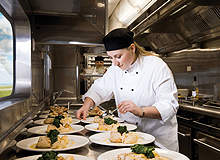
Excellent safety, design, durability and functionality are considered of the utmost importance when selecting any piece of equipment for a luxury train service, including catering equipment, which in providing a personalised service performs a different function from standard train services.
It’s a steel

Discover B2B Marketing That Performs
Combine business intelligence and editorial excellence to reach engaged professionals across 36 leading media platforms.
South Africa’s The Blue Train (there are two sets – the first accommodates 74 guests in 37 suites, the second 58 guests in 29 suites) takes passengers from Pretoria to Cape Town, over a distance of approximately 1,000 miles. Allen Pfister, executive chef at The Blue Train, says that from gas ranges and grills to ovens, salamanders, microwaves, deep fat fryers, bain-maries and hot closets, the equipment in his kitchens ensures "proper quality preparation, production and presentation of meals." They also use a stainless-steel design.
"Stainless steel, where available, is always preferable, along with compact, robust equipment," says Bradley Kerkman, food and beverage manager for Great Southern Rail’s (GSR) The Ghan, which travels 1,850 miles through the heart of Australia.
Jean Pierre Guerin, world-renowned chef and part of Canada’s Rocky Mountaineer culinary team, uses steel for its durability, high performance and cleanliness. "The kitchen is outfitted with stainless steel from top to bottom," says Guerin. "The galley consists of high-end professional series stainless steel equipment that includes fridges, ranges, flat tops, slow cookers and convection ovens."
Safely does it

US Tariffs are shifting - will you react or anticipate?
Don’t let policy changes catch you off guard. Stay proactive with real-time data and expert analysis.
By GlobalDataThe Rocky Mountaineer, which offers Canadian vacation packages through British Columbia and Alberta, was described as "the best train experience in the world" by The Society of American Travel Writers in June 2009. Its kitchen supports a seemingly non-stop meal service during its world famous two-day trips. "High performance and high output is key," says Guerin. "With limited room it is imperative that equipment is also safe, fits well into the space provided, performs well and supports the 144 sittings the kitchen will output over a two-day journey."
For safety reasons, The Blue Train uses non-slip items for stove-top use and covered deep fryers, a design says Pfister, that allows for "adequate moving and cleaning, and train movement and knocking".
The Ghan’s Kerkman says he requires safe equipment with "a low level of heat transfer, no sharp edges and a low probability of steam burns", and which is clearly labelled and easy to operate. Furthermore, he chooses equipment "that assists in removing knife work from work patterns", and will not consider deep fryers or exposed flames. "All equipment is electrical and no gas is carried on the train," he adds.
Replacement cycle
Maintenance is performed regularly on these luxury trains, which extends the equipment’s life. As a result, rather than having to replace equipment every couple of years, The Blue Train, for example, invests what Pfister describes as a "pretty extensive" budget every five years.
GSR works to a similar timescale. "While carriages were themselves built around 35 years ago, they are regularly maintained according to a strict time-based maintenance schedule," says Kerkman. "They receive an interior refurbishment approximately every five years, including renewal of equipment and refurbishment of furniture and fittings as necessary."
For the Rocky Mountaineer, equipment is usually replaced every ten years. "Rocky Mountaineer performs regular maintenance on its galley equipment during the off season. The maintenance programme is very comprehensive, which helps to preserve the lifespan of the equipment and reduce replacement," explains Guerin. "The vibration of the rails causes the bulk of the wear and tear on equipment on the train. Without a regular maintenance programme, equipment would have to be replaced every two years."
Purchasing
The supply of equipment for high-end trains comes from a mixture of places, including branded equipment for luxury offerings, as well catering suppliers and restaurant equipment suppliers. "There isn’t a manufacturer that specialises in railroad kitchen equipment," explains Guerin, who says that much of the train’s high-end professional-series stainless steel equipment is purchased from restaurant suppliers and adapted to meet the needs of the train and the galley. "The challenge is to source high-end electrical equipment that performs as well as gas," he says.
On The Blue Train, equipment is sourced from various suppliers, but vital to the kitchen, in Pfister’s opinion, is the immersion cooker due to its "slow cooking and precise temperature regulation, resulting in a moister and more flavourful end product".
The equipment available to luxury rail kitchens will no doubt follow the trends in catering for leading kitchens around the world, while new technology will bring new and interesting designs that can gradually be introduced onto the trains. But what is the one piece of equipment these rail travel culinary experts hope their teams will be cooking with one day? "Vacuum sealers would be a welcome addition," says Pfister, while Kerkman hopes to be using a multi-use oven in the future – "Ovens that are designed fit-for-purpose with improved heat extraction," he says.





